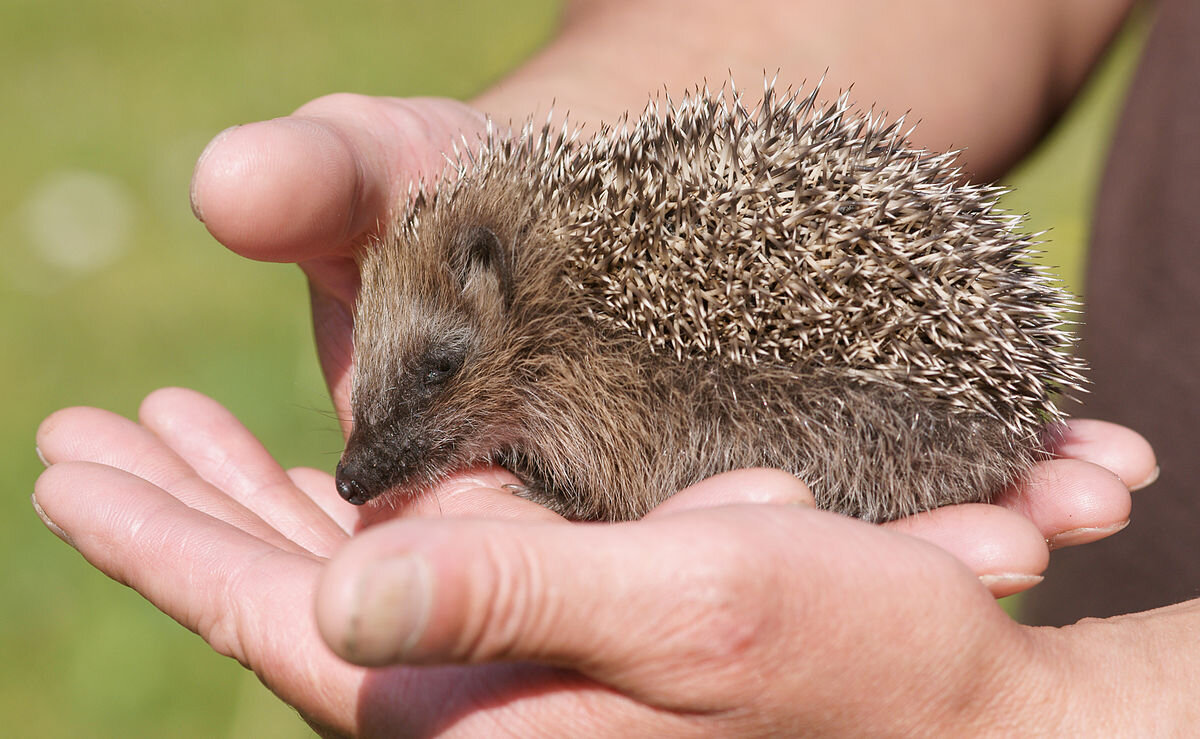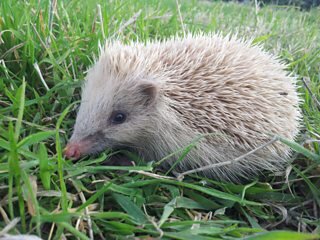A hedgehog (photo: Wikipedia)
Fact file
Latin name
Erinaceus europaeus
Threat status
Least Concern (Global)
Vulnerable (UK)
Identifying features
Unmistakable! About the size of a guinea-pig covered in spikey spines. You can see more images and video in the Camera trap Gallery.
Habitat
They prefer areas with grassland near woodland, scrub or hedgerows, including sand dunes with shrubs. Hedgehogs used to be prevalent in farmland, though less so now due to more intensive farming practices, increased pesticide use and loss of hedgerows.
They are quite common in gardens, especially in suburban areas. You can help to make your garden more friendly for hedgehogs by providing messy areas for them to nest in, and making sure there are ways in to your garden (such as small holes in the bottom of fences). PTES has cute ‘Hedgehog Highway’ signs for these holes!
Numbers
A juvenile hedgehog (photo: Wikipedia)
It is estimated there are only 522,000 hedgehogs in the UK from the Mammal Society Review of the Population and Conservation Status of British Mammals, and have declines since the Mammal Society’s last review in 1995. However, there is a lot of uncertainty in these estimates as hedgehogs are very under-reported, and so they may have declined by as much as 73%. It is because of the decline in numbers that they a listed as Vulnerable in the UK.
More information is needed on hedgehogs numbers, including any sightings. If you see a hedgehog anywhere, or even one sadly killed on the road, you can report the sighting to your local record centre or using the Mammal Mapper App.
Distribution
Western Europe: from Italy in the south to Scandinavia in the north, with an eastern edge around Poland. They are found across Great Britain and Ireland, as well as several islands including Skye, Orkney, Shetland and several of the Channel Islands. Many of these island populations are known to have been introduced, including a thriving population in New Zealand!
Unfortunately, introduced island hedgehogs can cause an issue with local wildlife. Hedgehogs regularly eat ground nesting bird eggs, which is thought to have contributed to the decline of breeding seabird colonies on some islands. They were also persecuted in the past for eating ground nesting game bird eggs.
Diet
Hedgehogs are insectivores, so they eat mostly insects and other invertebrates like earthworms and slugs. This makes them great for gardeners! Its estimated they need to eat 60 to 80g of invertebrates a night. They can also eat eggs of ground nesting birds, and will scavenge carrion when they find it.
If you would like to put food out for a hedgehog, do not give them milk and bread. This is an old wives tale, perhaps relating to the folk tale of hedgehogs stealing milk from cows! But adult hedgehogs are lactose intolerant, so cannot digest milk properly. Instead, you can give hedgehogs specialised hedgehog food, or high quality cat/dog food (especially with low fish content).
Size
Can be 26cm or more in length when adult, with males usually larger than females. When active, a hedgehog weighs about 800g, though this can double in preparation for hibernation! As they don’t eat during hibernation, hedgehogs lose about 25 to 40% of their body weight over winter.
To survive winter, a hedgehog needs to be about the size of a grapefruit when rolled up. If you see any smaller than this in autumn and early winter, please consider contacting your local wildlife rescue group. This is also true if you see hedgehogs during the day, as could indicate they are ill or desperate for food,
Life span
Maximum lifespan is about 10 years, though many do not make it to this old age. Mortality is quite high in the first year of life.
Breeding
Breeding period is around April to October, with two peaks of pregnancies; one in May-July and another in September. They generally have 4-5 babies per litter, which are called hoglets! Though is is possible for a hedgehog to have 2 litters in a season, this has only rarely been recorded in the wild.
Hedgehog footprints from a tunnel (photo: Hedgehog Street, also a great places for more information)
Survey techniques
Hedgehogs can often be seen in gardens at night, and can be searched for using a bright light - which doesn’t disturb them much. They are also easily seen on camera traps especially when baited with food.
A common survey technique is a footprint tunnel. Hedgehogs prints are distinctive, and weirdly look a little like handprints as they have wider palm prints than rats of squirrels (see to the left). It is possible to buy footprint tunnel kits, make your own, or sometimes hire them from your local mammal or wildlife group.
Hedgehogs also have quite distinctive droppings: they are blue-black, about 4-5cm long and often you can see shiny bits in it which are from the insects they eat. It also smells sweeter than you would expect!
Keep an eye out also for hedgehog hibernation nests in the autumn and winter. These can be found on the ground in sheltered cavities like log piles, under bramble or in the corner of sheds. They look like dome-shaped piles of leaves and grasses about half a metre wide. Be especially careful to check your bonfires for hedgehogs before lighting, and any piles of wood if you are clearing up your garden in winter.
They can also rest in long grass during summer days, so please double check before using a strimmer as well!
Legislation in the UK
Hedgehogs have some protection in UK legislation, which prevents them from being killed or captured by certain means. It also means they cannot be treated cruelly. However, this legislation does not prevent disturbance, or habitat destruction, unlike for some other UK species.
Alderney Blonde Hedgehogs
A blonde hedgehog from Alderney (photo: BBC)
Alderney in the Channel Islands has an introduced population of hedgehogs with a high proportion of ‘blonde’ individuals. This striking colour is known as leucistic in biological terms, which means a partial loss of pigmentation, though not full loss like albinism (this is also possible, though rare, in hedgehogs).
Though this coloration is possible in all hedgehog populations, Alderney’s has an unusually high number, around 25% of the population. This is a good example of a founder effect. A small number of individuals were introduced to this island which founded the entire population. Any unusual attributes of these individuals, like several of them being blonde, would then continue through the next generations - so that, in this case, the proportion of blonde individuals is higher, like the founders, rather than the mainland population.
Spiny Protection
A partially rolled-up hedgehog (photo: Wikipedia)
The hedgehog’s spines help to protect it against predators, especially when rolled up in its characteristic ball. This ball is very strong in a healthy hedgehog, making it difficult to unravel. They have a special muscle, called the orbicularis, which runs along the ‘skirt’ of their body, near their feet. When the muscle is tightened, it acts like a drawstring, drawing the spiny skin over the hedgehog’s legs, tummy and head to form a ball.
Hoglets are born with soft white spines which are replaced by harder brown ones as they grow. They can’t roll up at first, only after about 10 days of growth.
Rolling-up is excellent protection against most predators, except badgers which are strong enough to prize them apart. Sick or injured hedgehogs, however, might be too weak to roll-up properly, making them vulnerable to other predators like foxes and dogs. Again if you see a hedgehog out it the day, please take it to your local rescue centre.





